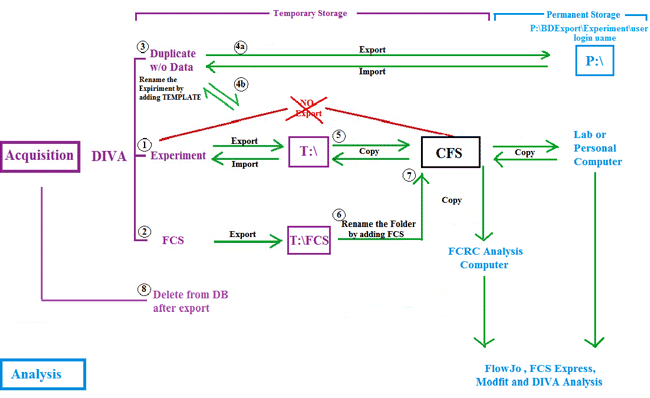Data generated from BD LSRII-1, BD LSRII-2 and BD LSR-Fortessa
IMPORTANT: No external HD or flash drives are permitted for use. Data generated from instruments or workstations of FCRC have to be moved to Rockefeller University File Store (RUFS, also called CFS) for storage or transferring to personal devices. For instructions click on Rockefeller Cloud Storage & File Shares.
- No personal data should be stored on the C:\ or D:\ drives of the instrument.
- No data or experiments should be exported to the D:\ drive. They should be exported to the T:\ drive for transfer to your CFS folders. Any data exported to the D:\ drive will be automatically deleted after 24 hours.
- Permanent data storage on the P:\ drive is limited by quota to 200MB. Windows will not allow you to store more than that amount. If you attempt to export more than 200MB to the P:\ drive, the export will fail. You may keep up to 200MB in your folder on the P:\ drive in perpetuity.
- Data storage on the T:\ drive is not limited by quota, but is limited to seven (7) days retention time. After seven days from date of export, the files will be automatically deleted.
- Data within the FACSDiVa software is not limited by quota, but is limited to seven (7) days retention time. After seven days from date of acquisition, the files will be automatically deleted.
- Researchers are responsible to make archival copies of their data immediately after they accomplished data acquisition:
- We suggest that researchers make at least two copies of the data and store them in separate locations.
- To conserve CFS space and costs, we suggest removing originals from CFS as soon as you have made copies of your data.

DETAILED INFORMATION for BD LSRII and BD LSR-Fortessa Data Management
Hard Drives on BD LSRII-1, BD LSRII-2 and BD LSR-Fortessa are set uniformly and split into several partition drives with different functionalities:
- C: (System)
- D: (BD Database)
- P: (Permanent)
- T: (Temporary)
To avoid possible data loss due to the operation of the system, please follow the instructions:
- Absolutely no experiments (with data or without data) will be allowed to store in the BD FACSDiva Browser/Database (within BD FACSDiva). Experiments left in the BD FACSDiva Browser/Database will be automatically deleted weekly.
- Absolutely no data of any kind should be stored at either C: (System) or D: (BD Database)
- At your first login into Windows using your RUNet Login and password you would get to a clean (empty) Desktop and My Documents folder.
- Personal folder is automatically created at – P:\BDExport\Experiment\uer login name. For your convenience, each user will be allowed to keep permanently up to 200 Mb of data in the new personal folder. This quota will not be allowed to be exceeded at any time. This quota will permit you to keep several essential Experiments and Templates on the local hard drive for your convenience. This is the only place for local permanent storage.
- Drive T: (Temporary) is created for commonly used temporary storage. All the data export should be directed through the new path – T:\ and T:\FCS on the BD LSRII computer. All the data left in T:\ and T:\FCS folders will be automatically deleted weekly. No limits for the folder sizes will be implemented there (other than actual disk space availability). To avoid problems, being exported from the BD FACSDiva Browser/Database, Experiment or FCS folders should be immediately transferred to your CFS Folder.
- If for any reason you are not able to login into Windows using your RUNet Login and password, feel free to login using the local login “fcrc” and password “BDLSR$pwd“. No data will be permitted for the storage on the Desktop. In this case, your Home and Laboratory Shared Folders on CFS will not be automatically accessible. To avoid problems, being exported from the BD FACSDiva Browser/Database, Experiment or FCS folders should be immediately transferred to your CFS Folder.